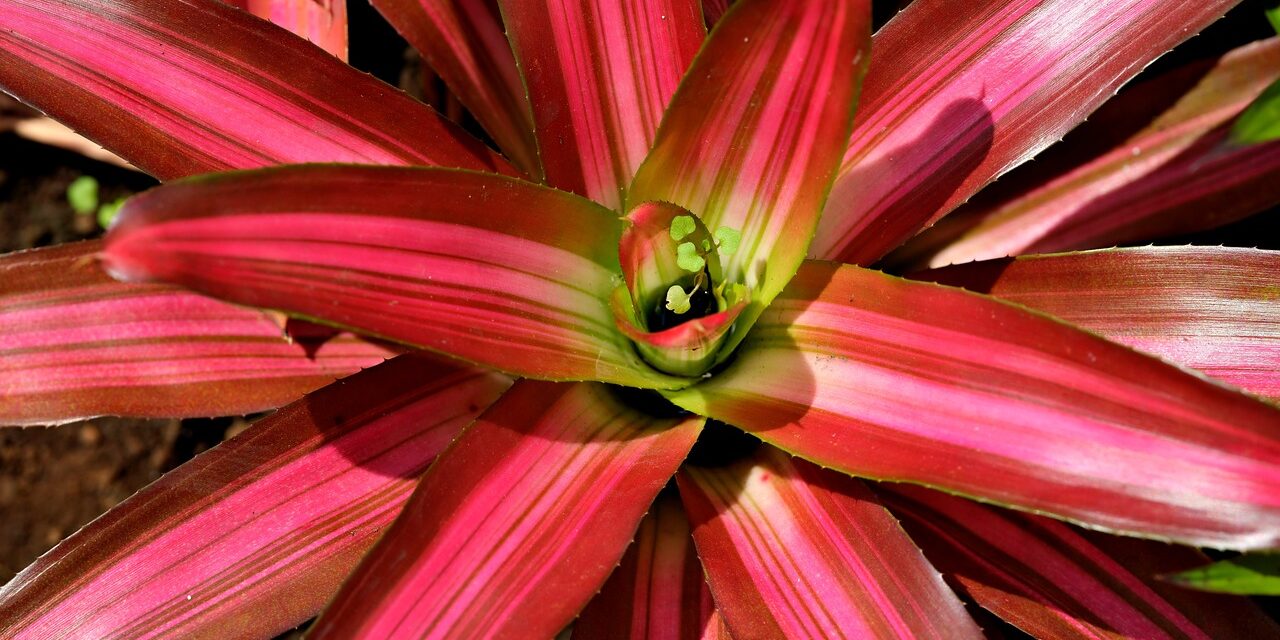Bromeliads (Bromeliaceae) come in a wide variety of shapes and sizes.
From leafy Bromeliads to Tillandsia usneoides (Spanish Moss) to Vriesea splendens to Aechmea fasciata, the Bromeliad is adored by many for its foliage and flower variations.
I purchased my first Bromeliad from IKEA and have had a few gifted to me over the years.
While I became familiar with and introduced to the plant, I was fascinated with the method by which you water; instead of watering the soil at the base of the plant, you keep the central “cup” amongst the leaves filled with water.
I prefer the Guzmania lingulata variation of Bromeliads for their beautiful, large flower head that grows at the center of the plant, in orange and red.
Table of Contents
Water, Lighting & Temperature for Bromeliads
Lighting, watering, and general care of Bromeliads differ a bit from other plants, so it’s important to know what your plant likes best to keep it healthy and thriving.
- Water — Fill the “cup” at the center of the Bromeliad leaves full of water and soil that maintains slight dampness. Don’t let the Bromeliad sit in too soggy soil, as they are quite prone to root rot and other issues when overwatered. You can also empty the cup occasionally and re-fill it to minimize the potential for bacterial overgrowths and/or mold issues.
- Light — Bromeliads like lots of sun to stay healthy, but not direct sunlight, as they are prone to burning if the light is too intense.
- Temperature & Humidity — Temperatures in the 70’s (Fahrenheit) are appropriate for Bromeliads, and they also benefit from routine misting.
- Soil — Sphagnum moss is an excellent medium for Bromeliads as an alternative to standard potting soil, as it allows for extra drainage and aeration.
- Propagation and Repotting — Generally, Bromeliads very rarely need to be repotted. If your Bromeliad is healthy and full of vigor, it will occasionally release a secondary “pup” that will sprout from its base. These pups can be split from the plant when they’re mature enough, with some root structures forming (which will take a few months), and placed in the soil as a separate plant.
The Bromeliad is for you if you’re a fan of gorgeous flowers and bright colors.
Keep the central cup of your Bromeliad full of water, give it lots of indirect light, and it should be reasonably easy to ensure your plant remains happy and productive.
Are Bromeliads easy to care for?
Bromeliads are usually easy to care for, especially compared to many other plants. They have relatively low light and watering requirements and do not need to be fertilized frequently. However, like all plants, bromeliads have specific care requirements that should be followed to ensure their health and longevity.
Where are bromeliads from?
Bromeliads are a diverse group of plants native to the southern tropical regions of the Americas, including Central America, South America, and the exotic Caribbean. Many species of bromeliads are epiphytic, meaning they like to grow on other plants or objects, such as trees or rocks, rather than in the ground. Some of the most well-known bromeliads include the pineapple and the Spanish moss that grows in the south.





